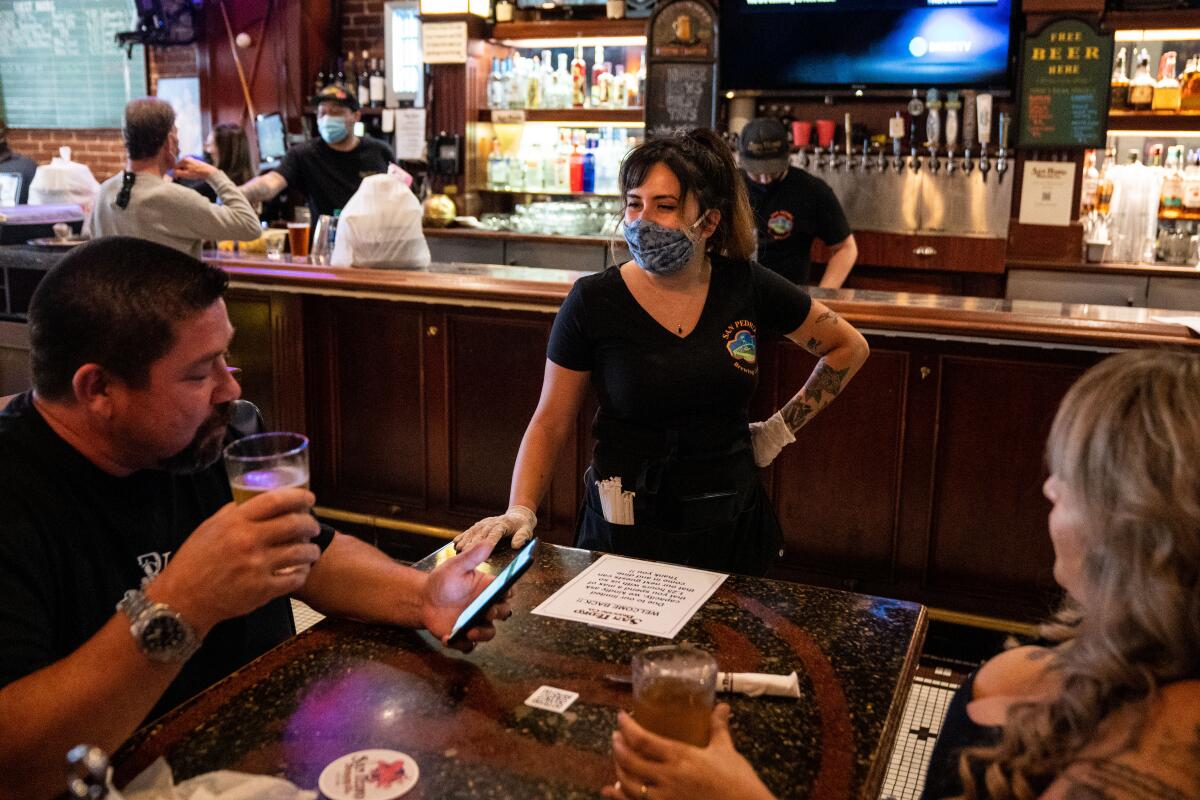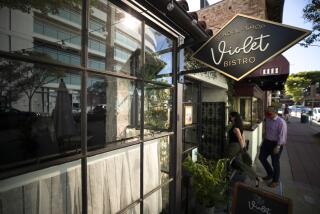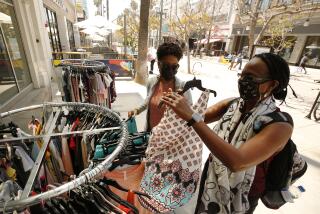In reopening restaurants and hair salons, L.A. County tests whether it can prevent second wave of coronavirus

- Share via
Despite having the most serious coronavirus outbreak in California, Los Angeles County on Friday was given the go-ahead to reopen restaurants for in-person dining, and resume services at barbershops and hair salons in the biggest test of whether the state can reopen the economy without causing COVID-19 to spread more rapidly.
Gov. Gavin Newsom approved a request by L.A. County leaders to begin the next phase of reopening and businesses could be up and running this weekend.
Many smaller counties across California already allow restaurants to start serving meals again with social distancing and other safety regulations. But those regions have been hit far less hard than Los Angeles County, and health officials said there is a clear risk that L.A. County’s move could fuel more outbreaks if rules are not strictly followed.
Over the past few weeks, California’s first-in-the-nation stay-at-home order has been rapidly loosened as Newsom and others said the coronavirus threat had eased. The order is credited with helping California avoid the huge death tolls of hot spots such as New York and New Jersey but has devastated the economy.
While many have praised the relaxations of the stay-at-home order, there have been growing concerns that it is coming too early for urban areas still vulnerable. Backers of the latest reopening plan believe the potential benefits outweigh the risks.
“This is a fine line that we’re walking in the county of Los Angeles,” County Supervisor Janice Hahn said Friday. “We are threading the needle between keeping the public safe and allowing our economy to reopen.”
L.A. County has recorded more than 2,200 coronavirus deaths. More than half of all COVID-19 fatalities in the state have been in L.A. County, which has been slower to reopen than areas less hard hit by the outbreak. The total number of confirmed infections in L.A. County is more than 50,000 — representing almost half of all California cases.
Just hours after the reopenings were announced, the county reported 50 additional coronavirus-related deaths Friday, bringing California’s total to more than 4,000. The county also confirmed an additional 1,824 new cases, bringing the total to 51,562.
Dr. Christina Ghaly, director of health services for L.A. County, said that although the numbers of local cases are flattening, the county may see a new upward curve as more businesses reopen and chances of transmission increase. But that wouldn’t necessarily mean that the county would have to backtrack.
Newsom and others acknowledged that while the death toll in L.A. County remains a major concern, other metrics show it’s safe to reopen the economy more. They point to reduced hospitalizations, infection rates and increased testing capacity.
Sign up for Essential California
The most important California stories and recommendations in your inbox every morning.
You may occasionally receive promotional content from the Los Angeles Times.
Hahn said officials have been working with the county’s Economic Resiliency Task Force, which includes experts from a variety of sectors, including the restaurant industry, to develop a detailed safety plan for in-restaurant dining. The plan includes diagrams showing how to separate tables six feet apart and proposes putting physical barriers between tables where such distancing isn’t possible, Hahn said.
As those plans suggest, things won’t immediately return to business as usual for the newly reopened establishments.
County public health officials are expected to announce restrictions on operations, including a 60% capacity limit for restaurants.
“Many of them will have to find creative ways to do that by utilizing their parking lots and the streets in front of their restaurants,” Hahn said.
Some communities, including the cities of Los Angeles and Long Beach, are preparing to close streets to traffic and expedite permit variances so restaurants can put more tables and chairs outside.
Both restaurants and salons are expected to be required to keep detailed records of customers, including contact numbers, so public health officials can quickly follow up with patrons in the event of an outbreak.
Environmental health inspectors will be out inspecting and providing guidance to newly reopened establishments, but the businesses are not required to undergo an inspection before they resume services, Barbara Ferrer, the county health director, said Friday.
“As we enter the weekend and we are out of our homes and visiting many of the reopened establishments because we’re all really hungering for some return to normalcy, I want to just note that the new normal that you’re going to see reflected in the businesses reflects the fact that COVID-19 is still very active in our communities and there’s a great deal at stake in the reopening,” she said.
Ferrer added that it continues to be crucial for people to practice physical distancing, wear a cloth face covering and stay home if they’re feeling sick.
“We do again want to note that the actions we take now are essential to making sure that people don’t become seriously ill, we don’t overwhelm our hospitals and we save people’s lives,” she said.
“It’s never been more important for businesses, individuals and institutions to use the tools that we have available to take care of each other and to continue to slow the spread of COVID-19.”
The state is developing a dashboard for counties to track statewide metrics related to improvements and pitfalls as modifications continue.
“If in fact the state determines that there’s a cause of concern, what they really are doing is offering technical support,” Ferrer said. The state wouldn’t necessarily inform a county to rescind its eased restrictions but would instead try to understand what is driving an increase in numbers to properly assist.
Restaurateurs and other business owners expressed relief and some concern about the move.
“I don’t think we’re going to scramble to open,” said Jon Yao, chef-owner of Kato in West L.A. “I think our timeline is going to be more in line with how we combat the disease instead of what the city says is OK.”
Some establishments expressed concern with the pace of the reopening.
“Personally I think it’s all a disaster,” said Josiah Citrin, chef-owner of Charcoal, Dear John’s, Citrin and Melisse. “It all went too fast; nothing’s been smartly done.”
Citrin said he plans to reopen Charcoal, his steakhouse in Marina del Rey, on Thursday. But things will look remarkably different: Instead of as many as 110 diners spread across booths, a communal table and the bar, he’s limiting capacity to 40 diners at a time, all at their own tables.
He has removed the bottles of steak sauce, chimichurri and barbecue sauce that used to remain on tables all day. No walk-ins will be allowed. Instead of 56 employees, he’ll have about 35.
The rush to reopen Charcoal, he said, is because the money he received from the federal PPP loan “is almost out.”
“I followed the rules, and I have almost no money,” he said. “I have a couple weeks left.”
He figures going to a restaurant is safer than shopping at a crowded grocery store and believes diners will return after being cooped up for so long.
“If cases start spiking and it gets really bad, then maybe people won’t go out,” he said. “But for now, what else can you do? You can’t go to a movie, you can’t go to a concert, you can’t go to a sporting game, so restaurants will be in pretty high demand.”
Still, with only 40 diners max at a time, he’s bracing for a significant revenue hit.
“It’s going to really hurt my bottom line. From now until this is over, it’s not about making money, it’s about surviving. It’s about finding ways to see another day.”
Johnny Ciccone, 42, owns Headbetter, a hair salon in Sherman Oaks that had eight chairs, four worked by employees and four worked by stylists who rented their space. It has been closed for the past 2½ months.
“We’ve just been decimated by this,” he said.
Even with the plans for reopening, Ciccone fears that as many as half of the city’s hair salons are still destined to fail.
“The only reason I’m still able to hang out at my salon is because there has been a moratorium on evictions. I did receive PPP funding but that was six weeks in and I haven’t been able to pay anyone or bring them back to work,” he said.
“For a lot of salons, it’s going to depend on the landlords. Are they willing to make deals? Maybe my landlord will make a deal with me, maybe not.”
Ciccone was told to close March 15. Prepandemic, Headbetter would see 25 to 30 customers a day. Ciccone estimates he will be able to serve about half that number under the new guidelines. Even as he talked about the reopening, workers were removing four of his eight chairs, in order to comply with the new spacing requirements. Ciccone added that it wasn’t as if he could just reopen and conduct business as usual — he must provide everyone with hand sanitizer, screen people for fevers before they enter and require both employees and clients to wear masks.
“One of the biggest changes is that there are not going to be any walk-in services,” he said. “Customers are going to have to wait outside until we are ready for them.”
He said he’s purchased thousands of masks and gloves and gallons of disinfectant and rubbing alcohol, as well as new point-of-sale card readers.
Even signage will require another outlay of money, Ciccone said. “The city has released sample signs, requiring social distancing, hand washing and other requirements, how we are going to be operating safely,” he said. “We have to have all that posted, so I’ll be dealing with that this weekend.
“For a small business like mine, we have spent a few thousand dollars getting ready for the reopening, changing chair layouts, other things.”
In spite of all this, Ciccone said, “I don’t think we are going to pass this on to our clients, especially if they have faced unemployment. They are going to have wait longer to get appointments. These are people I have a close relationship with. They have been going through the same tough times I’ve gone through.”
Anre Anduha, 35, who owns Brotherhood Barbershop in Sherman Oaks, said he’s also taken on a lot of debt.
“I’m $15,000 in debt now when I consider rent, my $400 to $500 DWP bills, cable bills and that’s not even counting the lost income,” he said. “When I open back up, I’m only going to be using four chairs.”
Before COVID-19 struck, Brotherhood Barbershop was always busy with appointments and walk-ins, averaging between 75 to 100 customers a day. It’s been closed since March 19.
Anduha also faces additional expenses, such as capes, “for every single client that comes in, instead of many switching capes two or three times in a day.”
Also, by contrast, hair salons do not typically rely on walk-ins for a significant slice of their business. That’s not the case with barbershops, which do rely on them. Anduha said that half of his business were people who just walked in, hoping to quickly find an empty chair and willing to sit around inside the shop to wait, which will not be allowed now.
“It’s supposed to be appointment only now,” said Anduha, who was already thinking about workarounds, depending on the peace of mind of the particular barber, especially if dealing with strangers. “Barbers may want to take a client’s temperature, ask whether they have been traveling. For the majority of those, we’d probably just write down their information, ask them to wait outside in case a chair opens up. You can’t just say ‘come on in, sit in a chair’ like we used to.”
In spite of being in debt, he was just as reluctant as Ciccone to raise prices as substantially as circumstances might warrant, noting that his customers have also suffered from issues such as lost work and income.
“Do I think I will survive? I really don’t have another option. I’ll have to. But we were already at a decent price level at $40 a cut,” Anduha said. “We might go to $45, but I’m not going to raise prices a lot right away.”
Times staff writers Ronald D. White, Hannah Fry, Rong-Gong Lin II, Jenn Harris and Peter Meehan contributed to this report.
More to Read
Sign up for Essential California
The most important California stories and recommendations in your inbox every morning.
You may occasionally receive promotional content from the Los Angeles Times.
















